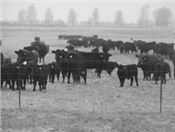Missouri Steer Feedout Provides Opportunity To Gather Data For Your Cattle's Resume

Steers
Photo credit: University of Missouri Extension
MT. VERNON, MO.
The 2019 Missouri Steer Feedlot will provide an excellent opportunity for cow-calf producers to pad their cattle’s resume. That is if the post-weaning feedlot performance and carcass data turn out favorably.
“More and more we talk up the need for feeder calf raisers to take a pro-active approach in marketing their cattle. Steer feedout results can be a valuable resume piece along with genomic results from half-sibs, expected performance differences (EPD) of recently used sires and other feedlot results,” said Eldon Cole, livestock specialist with University of Missouri Extension.
A resume takes time and effort to develop but the returns can be significant financially.
“After the feedout data reveals the worth of the cattle regarding gainability, health carcass quality grade, yield grade and overall profitability your next step is to share it with your market representative or a program of your choice,” said Cole.
The next Missouri Steer Feedout begins June 4 when fall and late summer 2018 steers are assembled and sent to southwest Iowa for finishing.
Pickup points are at Paris and Joplin Regional Stockyards, Carthage. Entry deadline is May 10.
An entry consists of five or more steer calves born after July 1 with a fee of $20 per head payable by the deadline. All other expenses will be deducted from steer receipts after the feedout.
The Missouri Steer Feedout is conducted in cooperation with the Tri-County Steer Carcass Futurity, (TCSCF), Lewis, Iowa, University of Missouri Extension and the Missouri Cattlemen’s Association.
The program is designed for both commercial and purebred breeders. Some purebred breeders encourage their bull buying customers to make entries.
For entry forms and more details can be found online at http://extension.missouri.edu/lawrence . ∆